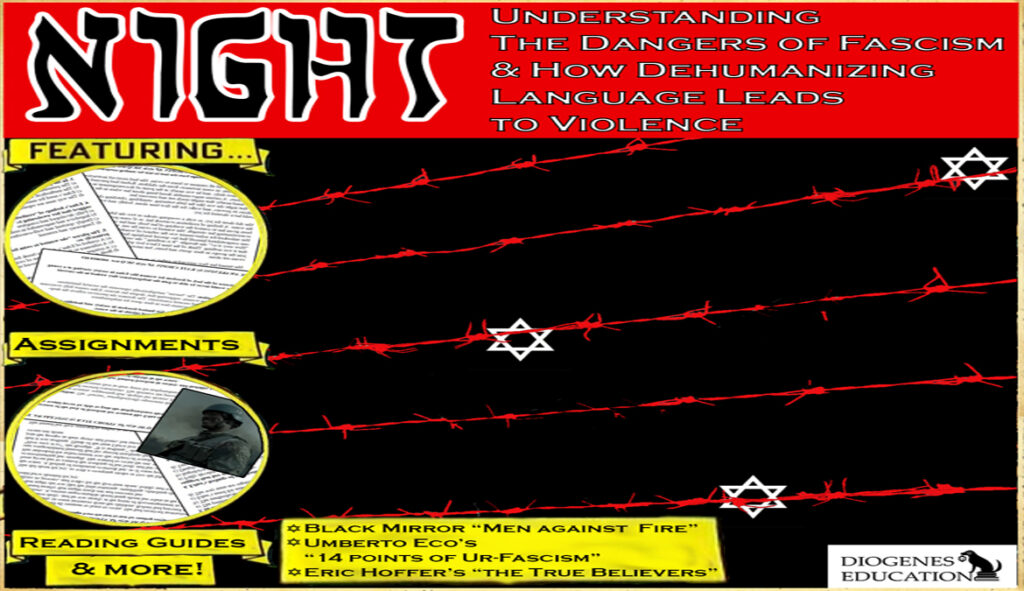
Night: Teaching the Dangers of Fascism and Dehumanizing Language With Literature

At the start of the year, a ninth-grade boy goose-stepped through my classroom. At the end of the year, he was telling another student not to say racist jokes. How did this change happen? We read Holocaust literature and examined the common symptoms of fascist regimes to find the the danger signs. No, I’m not a history teacher, but an English classroom is a great place to to teach history with the right stories and multi-media.
Teach The Holocaust with Literature

I often tell my students that most people are not convinced with facts but by passion, so every good argument needs their logos wrapped in pathos to be persuasive. The best way to make an argument to your students that anti-Semitism is a problem, that insulting jokes and anti-Semitic conspiracies against Jews are not appropriate, is by having literature put a human face to the atrocities of the Nazi regime. By teaching a unit on Elie Wiesel’s memoir Night, students empathize with the protagonist. But it’s not just about the dangers of The Holocaust, but all fascist movements and the tendency to create “others” and scapegoats. Other media, like Star Wars, the Black Mirror episode “Men Against Fire”, Todd Strasser’s The Wave, and key quotes from non-fiction texts like Eric Hoffer’s The True Believers, help to illustrate what gives rise to such evil.
Teach the Link Between Dehumanizing Language and Violence

Examine how dehumanizing language was used against minority groups, not just against Jews in The Holocaust (who were called any number of bestial metaphors), but also in the Rwandan Genocide against the Tutsis (who were called “Roaches”), against Muslims in the Bosnian genocide, against the Chinese by Japan’s Unit 731 during WWII, and is a precursor to every major genocide. Students can study the connotation of word choices and how they shape our thoughts, and compare major genocides to study the common link between them to learn the importance of speaking out before it’s too late.
Recognize the Warning Signs: Teach Umberto Eco’s “14 points of Ur-Fascism”

Umberto Eco noticed that fascist governments did not share economic or governmental policy. So, how can one recognize the dangers of fascism if they seem so different? He compared fascist regimes, (Hitler’s Nazi Germany, Mussolini’s Italy, etc.) and noticed that, although their governments might have operated under different policies, there was a core idea that remained the same: A palette swap of policy hiding the same contemptuous philosophy. Just as George Orwell wanted us to notice that his warnings about dictators in Animal Farm and 1984 could apply equally to the so-called Western World, students should learn the danger signs when they could happen closer to home: extreme militaristic nationalism, othering of minority groups, sexism and contempt of things considered “un-masculine”, propaganda that undermines journalists under a populist strong-man leader.
By the end of the unit, student’s wrote in their reflections, “I understand why it’s bad to make racist jokes,” and “reading about the terrible things people went through made me understand how awful The Holocaust was.” A far cry from their comments at the beginning of the year. In this day and age, we can’t afford not to teach students about The Holocaust, the effects of dehumanizing language, and the warning signs of fascism.
Get Started with Holocaust Literature Units in Your Classroom
Night by Elie Wiesel Unit: Fascism and The Holocaust lessons, activities, & test
Media Literacy & Fake News: Primary & Secondary Sources, Bias, Reliable Sources
Animal Farm Unit: pre-reading and allegory lessons, activities, assessments, game
Connotation and Denotation: Euphemisms L.9-10.5a RL.9-10.4 CCRA.R.4
Get a FREE SAMPLE lesson Artificial Intelligence ChatGPT: Connotation, Denotation, Descriptive Imagery

